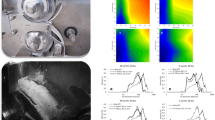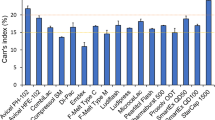Abstract
The present study shows that roller compaction (RC) can successfully be used as a granulation method to prepare hydroxypropyl methylcellulose (HPMC)-based extended release matrix tablets containing a high drug load, both for materials deforming mainly by fragmentation (paracetamol) as for those having mainly plastic deformation (ibuprofen). The combined effect of RC process variables and composition on the manufacturability of HPMC tablets was investigated. Standard wet granulation grade HPMC was compared with a larger particle size direct compressible HPMC grade. Higher roll pressure was found to result in larger paracetamol granules and narrower granule particle size distributions, especially for formulations containing smaller size HPMC. However, for ibuprofen, no clear effect of roll pressure was observed. High roll pressure also resulted in denser ribbon and less bypass fines during RC. Loss of compactibility was observed for granules compared to powder blends, which was found to be related to differences in granule porosity and morphology. Using the large-sized HPMC grade did in some cases result in lower tensile strength tablets but had the advantage to improve the powder flow into the roller compactor. This work also indicates that when the HPMC level lies near the percolation threshold, significant changes can occur in the drug release rate due to changes in other factors (raw material characteristics and processing).







Similar content being viewed by others
REFERENCES
Lapidus H, Lordi NG. Some factors affecting the release of a water-soluble drug from a compressed hydrophilic matrix. J Pharm Sci. 1966;55:840–3. doi:10.1002/jps.2600550818.
Alderman DA. A review of cellulose ethers in hydrophilic matrices for oral controlled-release dosage forms. Int J Pharm Technol Prod. 1984;5:1–9.
Larsson A, Abrahmsén-Alami S, Juppo A. Oral extended-release formulations. In: Gad S C, editors. Pharmaceutical manufacturing handbook: production and processes. John Wiley & Sons Inc; 2008. p. 1191–222.
Kleinebudde P. Roll compaction/dry granulation: pharmaceutical applications. Eur J Pharm Biopharm. 2004;58:317–26. doi:10.1016/j.ejpb.2004.04.014.
Augsburger LL, Vuppala MK. In: Parikh DM, editor. Theory of granulation. Book: handbook of pharmaceutical granulation technology, 2nd ed. New York: Marcel Dekker Inc; 1997. p. 7–24.
Leuenberger H. New trends in the production of pharmaceutical granules: batch versus continuous processing. Eur J Pharm Biopharm. 2001;52:289–96. doi:10.1016/S0939-6411(01)00199-0.
Li CL, Martini LG, Ford JL, Roberts M. The use of hypromellose in oral drug delivery. J Pharm Pharmacol. 2005;57:533–46. doi:10.1211/0022357055957.
Herder J, Adolfsson Å, Larsson A. Initial studies of water granulation of eight grades of hypromellose (HPMC). Int J Pharm. 2006;313:57–65. doi:10.1016/j.ijpharm.2006.01.024.
Am Ende MT, Moses SK, Carella AJ, Gadkari RA, Graul TW, Otano AL. Improving the content uniformity of a low-dose tablet formulation through roller compaction optimization. Pharm Dev Technol. 2007;12:391–404. doi:10.1080/10837450701369253.
Sheskey PJ, Hendren J. The effects of roll compaction equipment variables, granulation technique, and HPMC polymer level on a controlled-release matrix model drug formulation. Pharm Technol. 1999;23:90–106.
Saravanan M, Sri Nataraj K, Ganesh KS. Hydroxypropyl methylcellulose based cephalexin extended release tablets: influence of tablet formulation, hardness and storage on invitro release kinetics. Chem Pharm Bull. 2003;51:978–83. doi:10.1248/cpb.51.978.
Hariharan M, Wowchuk C, Nkansah P, Gupta VK. Effect of formulation composition on the properties of controlled release tablets prepared by roller compaction. Drug Dev Ind Pharm. 2004;30:565–72. doi:10.1081/DDC-120037487.
Malkowska S, Khan K. Effect of re-compression on the properties of tablets preprared by dry granulation. Drug Dev Ind Pharm. 1983;9:331–47. doi:10.3109/03639048309044678.
Sun C, Himmelspach MW. Reduced tabletability of roller compacted granules as a result of granule size enlargement. J Pharm Sci. 2006;95:200–6. doi:10.1002/jps.20531.
Shaw LR, Irwin WJ, Grattan TJ, Conway BR. The effect of selected water-soluble excipients on the dissolution of paracetamol and ibuprofen. Drug Dev Ind Pharm. 2005;31:515–25. doi:10.1080/03639040500215784.
Gupta A, Peck GE, Miller RW, Morris KR. Effect of the variation in the ambient moisture on the compaction behavior of powder undergoing roller-compaction and on the characteristics of tablets produced from the post-milled granules. J Pharm Sci. 2005;94:2314–26. doi:10.1002/jps.20414.
Rowe RC, Roberts RJ. In: Alderborn G, Nyström C, editors. Mechanical properties in pharmaceutical powder compaction technology. New York: Marcel Dekker; 1996. p. 283–322.
Nokhodchi A, Rubinstein MH, Larhrib H, Guyot JC. The effect of moisture on the properties of ibuprofen tablets. Int J Pharm. 1995;118:191–7. doi:10.1016/0378-5173(94)00354-8.
Eriksson L, Johansson E, Kettaneh-Wold N, Wikström C, Wold S. Design of experiments: principles and applications. 3rd ed. Umeå: MKS Umetrics AB; 2008.
Teng Y, Qiu Z, Wen H. Systematical approach of formulation and process development using roller compaction. Eur J Pharm Biopharm. 2009;73:219–29. doi:10.1016/j.ejpb.2009.04.008.
Thalberg K, Lindholm D, Axelsson A. Comparison of different flowability tests for powders for inhalation. Powder Technol. 2004;146:206–13. doi:10.1016/j.powtec.2004.08.003.
Cao X, Leyva N, Anderson SR, Hancock BC. Use of prediction methods to estimate true density of active pharmaceutical ingredients. Int J Pharm. 2008;355:231–7. doi:10.1016/j.ijpharm.2007.12.012.
Hancock BC, Colvin JT, Mullarney MP, Zinchuk AV. The relative densities of pharmaceutical powders, blends, dry granulations, and immediate-release tablets. Pharm Technol. 2003;27:64–80.
Rowe RC, Sheskey PJ, Owen SC. Handbook of pharmaceutical excipients. 5th ed. USA: Pharmaceutical Press; 2006.
Pitt KG, Newton MJ, Stanley P. Tensile fracture of doubly-convex cylindrical discs under diametral loading. J Mater Sci. 1988;23:2723–8. doi:10.1007/BF00547442.
Fell JT, Newton JM. Determination of tablet strength by the diametrical compression test. J Pharm Sci. 1970;59:688–91. doi:10.1002/jps.2600590523.
Souihi N, Dumarey M, Wikström H, Tajarobi P, Fransson M, Svensson O, et al. A quality by design approach to investigate the effect of mannitol and dicalcium phosphate qualities on roll compaction. Int J Pharm. 2013;477:47–61. doi:10.1016/j.ijpharm.2013.02.036.
Herting MG, Kleinebudde P. Studies on the reduction of tensile strength of tablets after roll compaction/dry granulation. Eur J Pharm Biopharm. 2008;70:372–9. doi:10.1016/j.ejpb.2008.04.003.
Prescott JK, Barnum RA. On powder flowability. Pharm Technol. 2000;24:60–85.
McKenna A, McCafferty D. Effect of particle size on the compaction mechanism and tensile strength of tablets. J Pharm Pharmacol. 1982;34:347–51. doi:10.1111/j.2042-7158.1982.tb04727.x.
Nokhodchi A, Rubinstein MH, Ford JL. The effect of particle size and viscosity grade on the compaction properties of hydroxypropylmethylcellulose 2208. Int J Pharm. 1995;126:189–97. doi:10.1016/0378-5173(95)04122-2.
Bacher C, Olsen PM, Bertelsen P, Sonnergaard JM. Compressibility and compactibility of granules produced by wet and dry granulation. Int J Pharm. 2008;358:69–74. doi:10.1016/j.ijpharm.2008.02.013.
Wikberg M, Alderborn G. Compression characteristics of granulated materials: VI. pore size distributions, assessed by mercury penetration, of compacts of two lactose granulations with different fragmentation propensities. Int J Pharm. 1992;84:191–5.
Wu CY, Hung WL, Miguélez-Morán AM, Gururajan B, Seville JPK. Roller compaction of moist pharmaceutical powders. Int J Pharm. 2010;391:90–7. doi:10.1016/j.ijpharm.2010.02.022.
Weyenberg W, Vermeire A, Vandervoort J, Remon JP, Ludwig A. Effects of roller compaction settings on the preparation of bioadhesive granules and ocular minitablets. Eur J Pharm Biopharm. 2005;59:527–36. doi:10.1016/j.ejpb.2004.09.012.
Juppo A. Relationship between breaking force and pore structure of lactose, glucose and mannitol tablets. Int J Pharm. 1996;127:95–102. doi:10.1016/0378-5173(95)04203-2.
ACKNOWLEDGMENTS
We acknowledge Lars Johnson (AZ) for his assistance with the permeability tests, Mervi Lindman (University of Helsinki) for taking SEM images of granules and Pirjo Tajarobi (AZ) for providing particle size data for paracetamol. HPMC DC Gen I was kindly supplied by Dow Pharma and Food Solutions.
Author information
Authors and Affiliations
Corresponding author
Electronic supplementary material
Below is the link to the electronic supplementary material.
ESM 1
(DOCX 134 kb)
Rights and permissions
About this article
Cite this article
Heiman, J., Tajarobi, F., Gururajan, B. et al. Roller Compaction of Hydrophilic Extended Release Tablets—Combined Effects of Processing Variables and Drug/Matrix Former Particle Size. AAPS PharmSciTech 16, 267–277 (2015). https://doi.org/10.1208/s12249-014-0219-3
Received:
Accepted:
Published:
Issue Date:
DOI: https://doi.org/10.1208/s12249-014-0219-3




